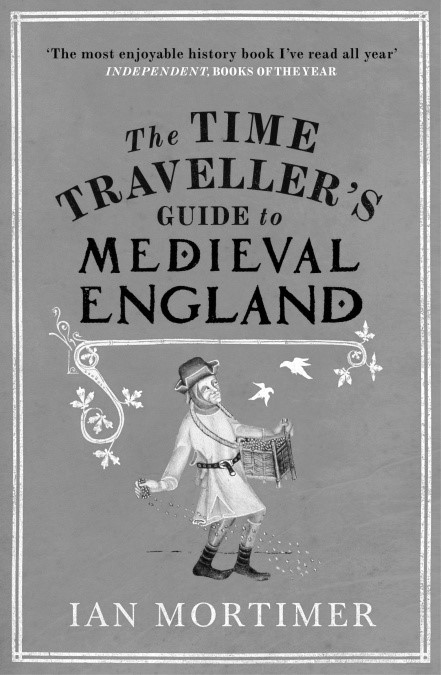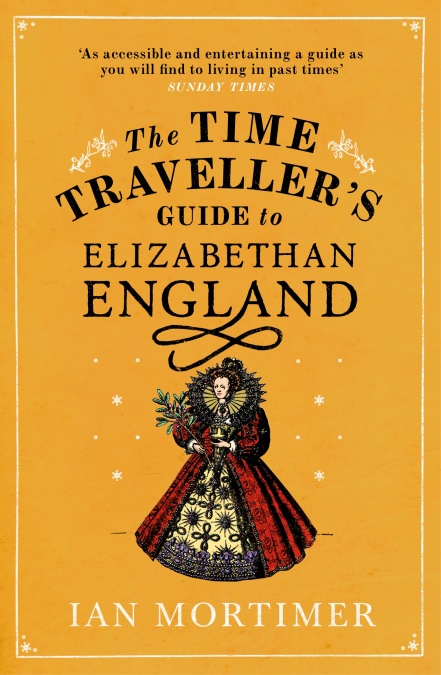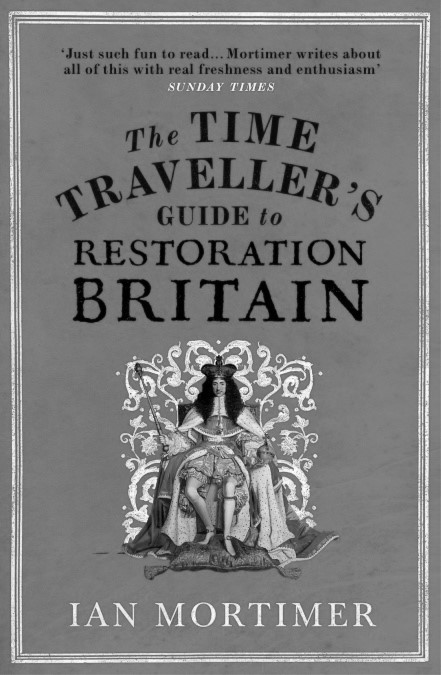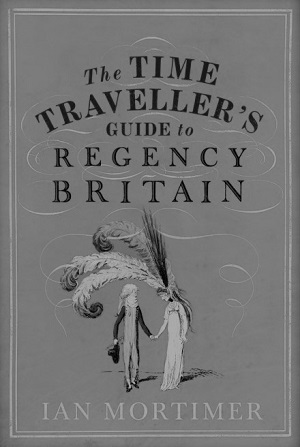|
The Time Traveller's Guide to Introduction It is a normal morning in London, on Friday 16 July 1591. In the wide street known as Cheapside the people are about their business, going between the timber-covered market stalls. Traders are calling out, hoping to attract the attention of merchants' wives. Travellers and gentlemen are walking along the recently repaired pavements of the street, going in and out of the goldsmiths' and moneylenders' shops. Servants and housewives are making their way through the market crowds to the Little Conduit near the back gate to the churchyard of St Paul's Cathedral, some with leather water vessels in their arms, others with casks suspended from a yoke across their shoulders. The morning sun is reflected by the glass in the upper windows of the rich merchants' houses. A maid looks down on those in the street as she cleans her master's bedchamber. Suddenly there is a great commotion near the market. 'Repent, England! Repent!' yells a man at the top of his voice. He is dressed in black, handing out printed leaflets as he strides along. 'Repent!' he shouts again and again, 'Christ Jesus is come with his fan in his hand to judge the Earth!' This man is no mean fool; he is a prosperous London citizen, Mr Edmund Coppinger. Another gentleman, Mr Henry Arthington, also dressed in black, is following him, stepping out from the alley called Old Change into Cheapside. He too calls out, declaring that 'Judgement Day has come upon us all! Men will rise up and kill each other as butchers do swine, for the Lord Jesus has risen.' The printed bills they hand out declare that they are intent on a complete reformation of the church in England. For the illiterate majority in the crowd, they call out their message: 'The bishops must be put down! All clergymen should be equal! Queen Elizabeth has forfeited her crown and is worthy to be deprived of her kingdom. Jesus Christ has come again. The reborn Messiah is even now in London, in the form of William Hacket. Every man and woman should acknowledge him as a divine being and lord of all Christendom.' William Hacket himself is still lying in bed, in a house in the parish of St Mary Somerset. He cuts an unlikely figure as a latter-day messiah. His memory is excellent - he can recall whole sermons and then repeat them in the taverns, adding amusing jokes. He married a woman for her dowry, then spent it and abandoned her. He is well known as a womaniser but he is even more famous for his uncontrollable and violent temper. Anyone who witnessed his behaviour in the service of Mr Gilbert Hussey will confirm this. When a schoolmaster insulted Mr Hussey, Hacket met with him in a tavern and pretended to try to smooth over the disagreement. After he had won the schoolmaster's trust, he put a friendly arm around his shoulders. Then, suddenly, he seized the man, threw him to the floor, flung himself on top of him, and bit off his nose. When he held up the piece of flesh the astonished onlookers entreated him to allow the bleeding schoolmaster to take it quickly to a surgeon so that it might be sewn back on, preventing a horrible disfigurement. Hacket merely laughed, put the nose in his mouth, and swallowed it. In his bed, Hacket knows what Messrs Coppinger and Arthington are up to: he himself gave them instructions earlier this morning. They believe he is the reborn Christ largely because he is such a persuasive and fervent character. Together they have been hatching a plot for the last six months to destroy the bishops and undermine the queen's rule. They have spoken to hundreds of people and distributed thousands of pamphlets. What Hacket does not know is that a huge crowd has started to swarm around his two prophesying angels. Some are curious, some are laughing at their proclamations; others want to join them. Most want to see Hacket in person. Such a large crowd is pressing against them that soon Mr Arthington and Mr Coppinger are trapped. They seek refuge in a nearby tavern, The Mermaid, and manage to escape by the back door, before returning to the parish of St Mary Somerset and their slugabed messiah. News runs through the city. By noon the city watchmen are marching from house to house. By one o'clock all three men have been sought out by the authorities and arrested. Within two weeks, two of them are dead. Hacket is tried for high treason, found guilty, and sentenced to death. On 28 July he is dragged on a hurdle to the gallows, hanged while he spits abuse at the hangman, then cut down and beheaded and butchered in the traditional manner, his headless body being cut into four parts, each with a limb attached. Mr Coppinger dies in prison: the authorities claim he starved himself to death. Mr Arthington enlists the support of powerful friends on the privy council and thereby saves his life, publishing his renunciation of all the things he has said as part of his penance. This is an unusual episode and yet it is evocative of Elizabethan England. Had it taken place two hundred years earlier, Hacket and his gentlemen supporters would have been given a wide birth by the nervous citizens, unused to such sacrilegious uproar. Had it taken place two hundred years later, these events would have been a cause for popular ridicule and a cartoonist's wit. But Elizabeth's England is different. It is not that it lacks self-confidence but that its self-confidence is easily shaken. The seriousness with which the authorities treat the plot, and the ruthless efficiency with which they suppress it, are typical of the time. It is not every day that a man is publicly proclaimed as the risen Christ, and it is extraordinary that well-respected gentlemen believe the messiah to be a violent, philandering, illiterate lout; but it is not at all unusual for Elizabethan people to adopt an extreme religious viewpoint, nor for them to fear the overthrow of the monarch. The last few decades have seen so much change that people simply do not know what to believe or think any more. They have become used to living with slow-burning crises that might, at any moment, flare up into life-threatening situations. This picture of Elizabethan England will come as a surprise to some readers. In the twenty-first century we are used to hearing a far more positive view of Elizabeth's 'sceptred isle'. We refer to the queen herself as Gloriana. We think of the defeat of the Spanish Armada, and Sir Francis Drake circumnavigating the globe in the Golden Hind. We think of writers such as Francis Bacon and Sir Walter Raleigh, the poets Edmund Spenser and Sir Philip Sidney, and the playwrights Christopher Marlowe and William Shakespeare. Surely a society that created such architectural masterpieces as Hardwick Hall, Burghley, Longleat and Wollaton Hall cannot be said to be anything other than triumphal? Surely a small kingdom that sends mariners into battle off the coast of Central America cannot be accused of self-doubt? The problem is that our view of history diminishes the reality of the past. We concentrate on the historic event as something that has happened and in so doing we ignore it as a story which, at the time, is happening. For example, when we hear the word 'Armada', we think of an English victory, in which the threatening Spanish ships were scattered and defeated in the battle of Gravelines, and after which Sir Francis Drake was feted as a hero. Yet at the moment of attack everything was up in the air. As Drake boarded his ship at Plymouth, he would have known that there was a real possibility of the Armada landing successfully and his own ship being sunk. He would have known that a change in the direction of the wind could alter everything - leaving his strategy in jeopardy and his fleet in danger. We can no longer imagine the possibility of the Armada disgorging its troops on English beaches. Our view of the event as a thing of the past restricts our understanding of contemporary doubts, hopes and reality. I wrote my first Time Traveller's Guide in order to suggest we do not always need to describe the past objectively and distantly. In that book I tried to bring the medieval period closer to the reader, describing what you would find if you could visit fourteenth-century England. Where would you stay? What might you wear? What would you eat? How should you greet people? Given that we know so much about the period, it stands to reason that the historian should be able to answer such questions. There are limits, of course: the historian cannot break through the evidence barrier and actually recreate the past. Moreover, imagining a personal visit is decidedly tricky in some matters of detail. You may well understand why the earl of Essex rebelled against Elizabeth in 1601 - but how did he clean his teeth? Did he wear underwear? What did he use for toilet paper? These things aren't so well evidenced. We must exploit what little evidence there is to satisfy, if only partially, our collective spirit of enquiry. What will strike you first if you visit Elizabethan England? I imagine that, to start with, it will be the smells of the towns and cities. After a few days, however, I suspect it will be the uncertainty of life. You will be appalled to see dead bodies lying in the street during an epidemic of influenza or plague, and the starving beggars in their filthy rags. You will be disconcerted to notice vulnerability even at the top of society. Elizabeth herself is the target of several assassination attempts and uprisings - from a gentry rebellion to her physician supposedly trying to poison her. Uncertainty pervades every aspect of life. People do not know whether the sun goes round the Earth or the Earth goes round the sun; the doctrines of the Church contradict the claims of Copernicus. The rich merchants of London do not know if their ships will be stranded in a North African port, with the crews massacred by Barbary pirates and their cargo stolen. To gauge what Elizabethan life is like we need to see the panic-stricken men and women who hear that the plague has arrived in the next village. We need to see the farmers in the 1590s, staring at their rain-beaten, blackened corn for the second year in succession. This is the reality for many Elizabethan people: the stark horror that they have nothing to feed their sick and crying children. We need to appreciate that such people, be they Protestant or Catholic, may well connect their starvation with the government's meddling with religious beliefs and traditions. We need to see them looking for something stable in their lives and fixing on the queen herself as a beacon of hope. Do not imagine the proud figure of Queen Elizabeth standing stiff and unruffled in her great jewelled dress on the deck of a serene ship, floating on calm sunlit waters. Rather imagine her struggling to maintain her position on the ship of State in heaving seas, tying herself to the mast and yelling orders in the storm. This is the real Gloriana - Elizabeth, Queen of England by the grace of God, the pillar of faith and social certainty in the dizzying upheaval of the sixteenth century. Like all societies, Elizabethan England is full of contradictions. Some practices will impress you as enormously sophisticated and refined; others will strike you with horror. People are still burnt alive for certain forms of heresy, and women are burnt for killing their husbands. The heads of traitors are still exhibited over the gates of the city of London, left there to rot and be a deterrent to others. Torture is permitted in order to recover information about treasonable plots. The gap between the wealthy and the impoverished is as great as ever and, as this book will show, society is strictly hierarchical. Humble houses - sometimes whole villages - are destroyed to make room for the parks of the nobility. People still starve to death on the highroads. As for the political situation, a brief note by a government official describes the state of the nation at the start of the reign:
This description is far removed from the 'golden age' interpretation of Elizabeth's reign - but there are at least as many positive contemporary verdicts as there are negative ones. In 1577, Raphael Holinshed publishes a chronicle in which he describes Elizabeth's accession in the following words:
One of the most striking differences between Elizabethan England and its forerunners lies in the queen herself. Elizabeth's personality and the rule of a woman are two things that make England in 1558-1603 a very different place from the England of Edward III or even that of her father, Henry VIII. More than ever before, the character of the monarch is intrinsically woven into the daily lives of her people. She is without doubt the most powerful Englishwoman in history. It is impossible to write about everyday life in her reign without reference to her. Her choice to steer England away from the Catholicism of her sister, Mary, and to re-establish an independent Church of England, as pioneered by Henry VIII, affects every person in every parish throughout the realm. Even if her subjects accept her religious choices, and never raise their heads above the religious parapet, her decision-making touches their lives in numerous ways. The Prayer Book changes, church symbols are torn down and bishops are replaced. An individual might become persona non grata just because of his or her religious doubts. If ever there was an argument that rulers can change the lives of their subjects, it lies in the impact of the Tudor monarchs. Elizabeth's kingdom is very much Elizabethan England. This book follows my medieval guide but it does not entirely adopt the same form. It would be tedious to make all the same observations about aspects of daily life that contrast with our own society. Moreover, in writing about Elizabethan England, it would be inappropriate to follow exactly the same formula developed to describe the realm of two hundred years earlier. It is not possible, for example, to relegate religion to a subsection in this book: it has to be a chapter on its own, being integral to the ways Elizabethans live their lives. The England of 1558 has much in common with the kingdom in 1358 but a great deal has changed. As a result this book is not only concerned with the way Elizabethan England compares with the present day, it also examines how it compares with, or differs from, its medieval roots. The historian is always a middle man: the facilitator of the reader's understanding of the past. I am no different, even though this book is written in the present tense and based on the premise that the most direct way to learn about something is to see it for yourself. However, in a book like this, my relationship with the evidence is unusual. Obviously literary texts have been important (plays, poetry, travellers' accounts, diaries, contemporary surveys), as have been a wide range of printed records. But making sense of all this evidence as indicative of lived behaviour requires the historian to draw on personal experience. As I put it in The Time Traveller's Guide to Medieval England, 'The key to learning something about the past might be a ruin or an archive but the means whereby we may understand is - and always will be - ourselves.' This goes for the reader's lived experience too. For example, I presume that readers of this book have not seen a bull-baiting contest but yet have enough life experience to imagine what is involved, and thus to know that the Elizabethans' love of this form of entertainment makes them profoundly different from modern English people. I have been reluctant to include details from outside the period of the reign. Very occasionally I have cited post-1603 evidence but only in order to illustrate a procedure or practice that certainly existed before 1603. There is more citation of pre-1558 sources: much of Elizabethan England is composed of relics from the late medieval and earlier Tudor periods. This applies obviously to the castles, town walls, streets and churches; but it also applies to books that were printed for the first time in earlier reigns and which are re-read and often reprinted in Elizabethan times. It especially applies to legislation: most of the law is based on medieval precedents, and it goes without saying that all the laws in force at Elizabeth's accession date from an earlier period. It is important to remember that every house and structure that we call 'medieval' or 'Tudor' because of its date of construction is also Elizabethan. The same applies to many phrases and customs that were in use and practised before 1558. On this point, readers will note several references to the wonderful Latin phrasebook Vulgaria by William Horman, first published in 1519 (I used the 1530 edition). Horman is vividly expressive of the most basic aspects of daily life, so we learn that 'unwashed wool that grows between the hind legs of a black sheep is medicinable' and 'some women with child have wrong appetite to eat things that be out of rule: as coals'. As his purpose was to provide daily Latin in order to encourage the resurgence of the spoken language, we can be confident these examples reflect the experiences of his readers. And while anything written by him about fashionable clothes or religion is, of course, hugely out of date by 1558, what he says about some pregnant women's appetites is as true today as it was in 1519. Bearing in mind these caveats, I have done my best faithfully to represent England as it existed between Elizabeth's accession on 17 November 1558 and her death on 24 March 1603. Welcome, then, to Elizabethan England, and all its doubts, certainties, changes, traditions and contradictions. It is a jewel-encrusted muddy kingdom, glittering and starving, hopeful and fearful in equal measure - always on the point of magnificent discoveries and brutal rebellions. |



